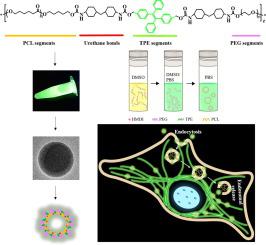Journal of Colloid and Interface Science ( IF 9.4 ) Pub Date : 2020-09-08 , DOI: 10.1016/j.jcis.2020.08.113 Yuqing Niu 1 , Bokai Zhang 2 , Massimiliano Galluzzi 2

|
The specific binding of fluorescent probes or biomolecules to the actin cytoskeleton network is increasingly important for monitoring various complex cellular activities such as cell adhesion, proliferation, locomotion, endocytosis, and cell division. However, improving cell uptake and subcellular resolution is still the main obstacle for successful and wide application of cellular fluorescent probes. Here, we designed and synthesized an amphiphilic block polyurethane with peculiar photophysical properties of aggregation induced emission (AIE), which can be used in living cell imaging to promote selective visualization of cell structures. The AIE effect polyurethane (abbreviated as AIE-PU) was prepared by two-step polymerization of diisocyanate terminated polyethylene glycol and polycaprolactone with hydroxyl terminated AIE dye. A series of characterization techniques proved the successful synthesis of AIE-PU. Due to the amphiphilic chain segment of its linear block molecule, AIE-PU block copolymers can self-assemble into spherical nanoparticles in aqueous solution, showing relatively stable photophysical properties and good water dispersion. Cellular experiments demonstrated that AIE-PUs have low toxicity and high actin network affinity. Moreover, the uptake mechanism was studied by low temperature and metabolic inhibition experiments, showing that AIE-PU nanoparticles could be easily internalized into different living cells through energy-dependent endocytosis, and can be transported from the cellular periphery to the actin network via clathrin- and caveolae-dependent transport pathway. Upon binding with the actin network, the inter-chain AIE mechanism of the probe was significantly enhanced, which is pivotal for the long-term stable fluorescence imaging of actin microfilament network in living cells. Finally, compared with commercial actin dyes, this probe showed higher photostability, even after a longer retention time, without significant fluorescence quenching.
中文翻译:

两亲聚集体诱导发射聚氨酯探针,用于在活细胞中原位观察肌动蛋白。
荧光探针或生物分子与肌动蛋白细胞骨架网络的特异性结合对于监测各种复杂的细胞活动(例如细胞粘附,增殖,运动,内吞作用和细胞分裂)越来越重要。然而,提高细胞摄取和亚细胞分辨率仍然是成功和广泛应用细胞荧光探针的主要障碍。在这里,我们设计并合成了具有聚集诱导发射(AIE)特有的光物理特性的两亲性嵌段聚氨酯,可用于活细胞成像以促进细胞结构的选择性可视化。通过二异氰酸酯封端的聚乙二醇和聚己内酯与羟基封端的AIE染料的两步聚合来制备AIE效果聚氨酯(简称为AIE-PU)。一系列表征技术证明了AIE-PU的成功合成。由于其线性嵌段分子的两亲链段,AIE-PU嵌段共聚物可以在水溶液中自组装成球形纳米颗粒,显示出相对稳定的光物理性质和良好的水分散性。细胞实验表明,AIE-PU具有低毒性和高肌动蛋白网络亲和力。此外,通过低温和代谢抑制实验研究了摄取机制,结果表明AIE-PU纳米颗粒可以通过能量依赖性内吞作用轻松地内化到不同的活细胞中,并可以通过网格蛋白-C从细胞外围转运至肌动蛋白网络。和依赖小窝的运输途径。与肌动蛋白网络结合后,探针的链间AIE机制显着增强,这对于活细胞中肌动蛋白微丝网络的长期稳定荧光成像至关重要。最后,与市售肌动蛋白染料相比,即使在更长的保留时间后,该探针也显示出更高的光稳定性,而没有明显的荧光猝灭。











































 京公网安备 11010802027423号
京公网安备 11010802027423号